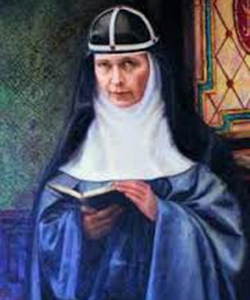Saints of the Order

 St. Elisabeth Hesselblad
St. Elisabeth Hesselblad
Maria Elizabeth Hesselblad was the fifth of thirteen children born to August Robert Hesselblad and Cajsa Petersdotter Dag, a Lutheran family in Fåglavik in Västra Götaland County.
By 1886, she had to work to help them make ends meet. At first she looked for work in Sweden, but eventually emigrated to the United States of America in 1888, where she studied nursing at Roosevelt Hospital in New York City. While there, she did home nursing, which brought her into contact with the Catholic faith of many of the poor for whom she cared. She developed an interest in that faith, and on 15 August 1902 she received conditional baptism from a Jesuit priest, Giovanni Hagen, in the chapel of the Convent of the Visitation in Washington, D.C.
As a religious:
Hesselblad then made a pilgrimage to Rome, where she received the sacrament of Confirmation. She also visited the House of St. Bridget of Swedenthere, where the medieval saint had spent the last half of her life, which made a deep impression upon her. At that point she felt called to dedicate her life to the work of Christian unity. She returned to New York briefly, only to go back to Rome, where, on 25 March 1904, she was welcomed as a guest by the nuns of the Carmelite monastery housed there. She petitioned the Holy See to be able to make religious vows under the Rule of the Order which Brigid had founded, and had been a prominent presence in the Church in Sweden before the Protestant Reformation had taken hold there. She received special permission for this from Pope Pius X in 1906, at which time she assumed the Bridgettine religious habit, including its distinctive element of a silver crown.
Hesselblad attempted to revive interest in the Order and its founder in both Sweden and Rome. Her proposal to establish a monastery of the Order on the site where Bridget had lived received no volunteers from the few monasteries of the Order still in existence. Giving up on the intention of following the established way of life in the Order, she proposed one which included the care of the sick. To this end she was joined by three young women from England, whom she received on 9 November 1911, with which the new congregation was established. Their particular mission was to pray and work, especially for the unity of Scandinavian Christians with the Catholic Church.
Hesselblad returned to her homeland of Sweden in 1923, where she was able to establish a community in Djursholm, while she worked nursing the sick poor. The new congregation was established in England in 1931. That same year, Hesselblad obtained the House of St. Bridget in Rome for her new congregation. A foundation was made in India in 1937 which drew many new members.
Hesselblad also worked at efforts at inter-religious dialogue and against racism, and became known as "the second Bridget".
The Footsteps of Blessed Mary Elizabeth Hesselblad
1870 - born in Fåglavik (Sweden)
1888 - looking for work, to help her large family, she went to America.
1900 - Begins her conversion to Catholicism that leads to baptism (1902), and to the encounter with the house of St. Bridget in Rome.
1911 - At home in Rome in Via Monserrato receives three aspiring British with whom begins the new foundation,
1919 - Various foundations in Sweden (1923), Switzerland (1924), England and Piazza Farnese in Rome (1931) and finally after 350 years,
1935 - Vadstena (Sweden).
1937 - Send her daughters to lndia .
1939/1945 Missionary and zealous Spirit for unity of Christians, was distinguished for charity during the armed conflict,
1955 - received wide recognition.
1957 - She died in Rome in the house of Saint Bridget, offering her life to join Sweden in Rome.
April 9, 2000 Beatification
San Pietro Square, in Rome, by St. John Paul II
June 5th 2016
San Pietro Square, in Rome, by Pope Franc
Back



